What could be the scheme of heating in a private house: a
When arranging the heating system of a private house, it is very important to choose and draw up the correct scheme for connecting all heating elements. Only in this way you can achieve the greatest efficiency and economy in the process of its operation.
In this article we will consider all possible options for performing such a task.
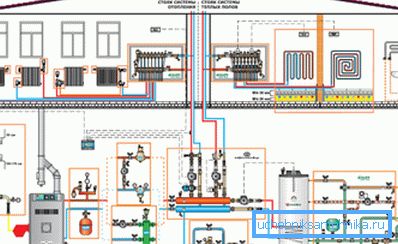
Terminology

Heating schemes in a private house use some terms that may be unfamiliar to a wide range of ordinary people, let's analyze them:
| Term | Explanation |
| Water heating device | Equipment that is heated by contact with the coolant, itself spreads heat throughout the room. These can be batteries, radiators, convectors, heated floors, and other similar units. |
| Heat carrier | Fluid moving through the pipes of heating. It heats up in the boiler and transports heat to the radiators. Usually this role is performed by water, which can be modified by various special additives. |
| Heating circuit | The closed design moving the heated and cooled water on itself. Consists of radiators, piping, cranes and other equally important elements. |
| Direct move | The section of the contour transporting the heated coolant to the radiator. |
| Reverse | The section of the contour transporting the cooled coolant after exiting the radiator. |
Tip: in regions with severe winters, it is recommended to use water as a coolant in combination with ethylene glycol. Such antifreeze will not freeze even in the most critical conditions when the system is completely off.
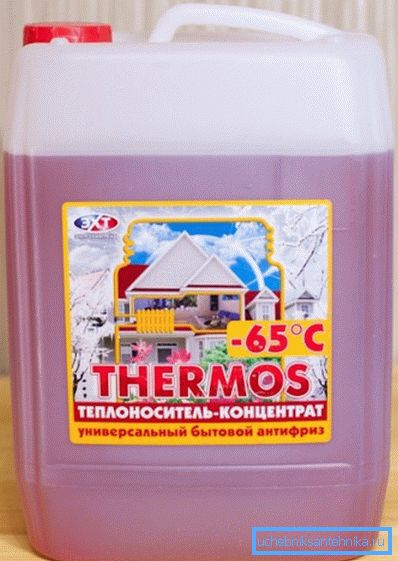
Possible methods for transferring coolant
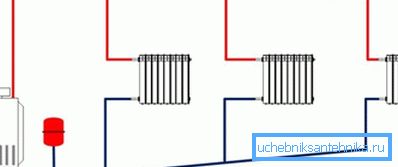
When a scheme for heating a private house with your own hands is drawn up, the first thing to consider is the organization of the movement of the coolant around the circuit:
| Circulation | Description |
| Natural | Such a system works by fulfilling physical laws. The heated liquid has a lower density and is displaced upwards along the riser, from where the contour, equipped with a slope of three to five degrees, spreads to the whole body. The cooled water already on the return stroke, having the same angle of inclination, returns to the boiler. Distinctive features:
|
| Forced | In this case, a circulation pump is additionally connected to the system, and, therefore, the coolant movement occurs due to the pressure difference created between the forward and reverse stroke. Distinctive features:
|

Schemes in accordance with the used pipe wiring
Also, when creating a heating scheme for a private house with your own hands, you should choose the method of connecting batteries to the riser:
Single pipe

In this embodiment, the heated liquid moves all the time along the same pipe, consistently giving off heat to radiators encountered along the way.
The advantage is the low selling price, but tangible drawbacks make you think about its rationality:
- Uneven heat distribution. The farther from the boiler, the colder the battery.
Tip: the use of single-pipe schemes is only suitable for small spaces where heat losses will be less noticeable.
- The difficulty of adjusting individual radiators. Changes made to the work of one will affect all devices in a consistent chain.
- The inability to carry out repairs or replacements without stopping and shutting down the entire system.
Twin tube
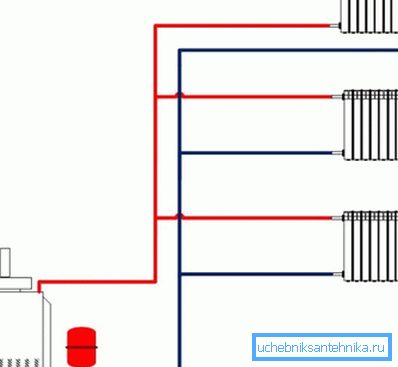
Here, to each radiator, the heated fluid is fed through one pipe, and the already cooled one is removed by another. The design can have both vertical and horizontal wiring.
Of course, such a choice will cost more, but it provides several undeniable advantages at once:
- Uniform distribution of heat, which significantly improves the microclimate in the house and increases system performance.
- The ability to adjust any of the radiators without consequences for the rest.

All over the world it has long been actively used just such a parallel connection of radiators not only in private houses, but also in multi-apartment high-rise buildings. We have so far this innovation can usually be found only in new buildings or country cottages.
Ray

Such a connection is also called a collector, since it assumes the presence of a distribution manifold, from which the supply and return pipe for each battery is already supplied individually.
Before you make such a layout, you should carefully weigh your financial possibilities, because it will be more expensive than even a two-pipe one, but it will provide you with truly unique opportunities:
- Full autonomy performance adjustment of each radiator from the collector.
- Repair or replace batteries without shutting down the entire heating system.
- The ability to install additional devices on any circuit.
Installation instructions for installation of the radial wiring is highly complex, which makes it obligatory to call qualified specialists.
Leningradka
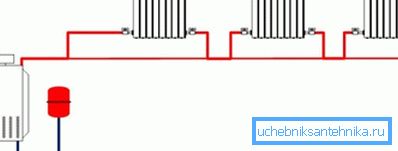
This original method allows to improve the one-pipe connection scheme of the heating system, endowing it with the possibility of autonomous adjustment of radiators.
For this:
- For each battery, valves are mounted that allow you to control the flow of coolant through it.
- Bypasses are installed, which are bypass pipes of a smaller size. This will allow water to circulate around the entire circuit, even with valves completely closed on a separate radiator.
It is noteworthy that the described manipulations can be carried out both at the initial stage of arranging the heating in the house, which will allow both to save money and expand the functionality of the structure, and with the wiring already installed.
Conclusion
If you decide to carry out the heating of a private house with your own hands, then you should start by choosing the most appropriate wiring diagram for your case. The first step is to determine the type of circulation of the coolant in the pipeline, and then with the option of distributing used pipes. Above, we tried to acquaint you with the principles of work and the strengths of the most popular ones.

On the provided video you can find additional materials relating to the topic. The correct scheme is a guarantee of quality heating.